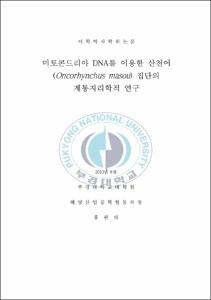미토콘드리아 DNA를 이용한 산천어(Oncorhynchus masou) 집단의 계통지리학적 연구
- Abstract
- 본 연구의 목적은 유전자 마커를 이용하여 국내 산천어의 유전적 다양성 및 구조를 밝혀 외래종의 분포현황을 파악하고 우리나라 토종 산천어를 확보하기 위해 실시하였다. 또한 획득된 유전 정보를 이용하여 토종 산천어의 생태계 보존과 자원관리를 위한 기초자료를 제공하기 위함이다.
국내에서 서식중인 산천어와 시마연어 85개체의 미토콘드리아 DNA ND5 유전자의 염기서열을 비교분석한 결과 10개의 염기변이 영역이 관찰되었으며, 총 7개의 유전자형을 결정하였다. 고진동 계곡과 부연동 계곡 개체군의 유전적 다양도는 타 집단보다 높았고, 유전적으로도 타 집단과 다르게 나타났다.
극동아시아 지역 서식 산천어 집단의 haplotype 다양성은 높은 반면에 nucleotide 다양성은 매우 낮게 나타났고, haplotype 간 haplotype간 유전적 차이가 크지 않았다. 또한 집단유전학적 역학 구조 분석을 실시하여 집단의 분화 양상을 파악한 결과 Fu’s Fs와 Tajima’s D값, Mismatch distribution 그래프, goodness-of-fit tests 결과 PSSD 결과는 극동아시아지역 산천어 집단은 최근에 급속도록 팽창되었음을 보여주었다.
통계학적 방법인 pairwise FST 수치를 이용하여 집단간 유전적 차이점을 확인한 결과 부연동 계곡과 고진동 계곡 집단은 일본과 러시아 집단과 유전적 차이를 보였으며, 송현천과 연곡천 집단은 유전적으로 러시아 집단과 매우 가깝게 나타났다. 특히, Nested clade analysis분석결과 부연동계곡의 경우 확인된 유전자형은 타 집단의 유전자형과는 매우 이질적인 것으로 나타났고, 고진동 계곡의 경우 고유 유전자형의 검출 빈도가 월등히 높은 것으로 미루어 보아 이 들 두 집단은 타 집단과의 유전자 교류가 적게 일어나고 있음을 시사한다.
본 연구 결과를 종합해 볼 때, 타 지역 및 외래종과 유전적으로 차이를 보이는 고진동 계곡과 부연동 계곡 집단은 우리나라 고유 산천어일 가능성이 매우 높음을 시사해 주고 있어 이들의 관리를 위한 구체적이고 체계적인 연구가 수행되어야 할 것이다.
Masu salmon, Oncorhynchus masou, are found only in the Far East, including Korea, Russia, and Japan, particularly in the East Sea, the Sea of Okhotsk, and the Northern Pacific Ocean (Kato, 1991). In Korea and central Japan, there are both river-resident type and anadromic type populations.
Genetic variation is important for the long-term survival of natural populations, because it confers the ability to adapt to changing environmental conditions, through the increase of fitness (Frankel and Soulé, 1981). Analyzing maternally inherited mtDNA is a useful and important way to investigate the genetic variation of populations of aquatic organisms. Many fish species, including salmons, have been genetically analyzed based on mtDNA (Park et al., 1993). Recently, Sato et al. (2001) and Yu et al. (2010a) found greater variation using nucleotide sequences in mtDNA of chum salmon and masu salmon. In particular, the NADH dehydrogenase subunit 5 (ND5) region of mtDNA may be a useful genetic marker, because it is conserved across all organisms and has a fast evolutionary rate (McKay et al., 1996; Verspoor et al., 1999).
This study was to estimate genetic variation and population genetics of masu salmon, O. masou, based on a 561bp mitochondrial NADH dehydrogenase subunit 5 (ND5) gene. A total of 249 fish representing 12 populations collected from 10 river-resident type and 2 anadromic type populations was analyzed. The analysis of ND5 nucleotide sequences revealed not only 10 variable sites, which defined 7 haplotypes, including some associated with their life cycle type but also 14 variable sites, which defined 14 haplotypes. Genetic diversity of Gogindong (GOL) and Buyeondong (BUL) populations were higher than those of Songhyon (SOL) and Yeongok (YOL) among river-resident type populations. Pairwise population FST estimates and neighbor-joining tree analyses inferred that river-resident of GOL and SOL were distinct with other same life type population and anadromic types In addition, both GOL and SOL populations showed clear genetic differences with Japanese and Russian populations. Other Korean populations did not distinguish Russian samples.
The nested 95% set of plausible cladogram for the observed 7 ND5 haplotypes from Korean masu salmon populations was constructed with Nested Clade Analysis. A focal haplotype and derived haplotypes showed a clear star-like genealogy. The high haplotype diversity and limited nucleotide diversity of masu salmon populations suggest the rapid population expansion from an ancestral population with small effective population size. Neutral expectations and historical demographic expansions were investigated using Fu’s Fs and Tajima’s D tests, and mismatch distributions with sudden expansion model. For all populations together Fu’s Fs and Tajima’s D values were negative from the neutral evolution model. The mismatch distributions of masu salmon in the Far East populations appeared to be unimodal. The goodness-of-fit test did not reject the null hypothesis of sudden population expansion. Thus, all of above tests indicate a recent expansion of masu salmon.
In conclusion, this study found significant genetic differentiation of populations between two Korean populations (GOL and BUL) and other populations, which the two differentiated populations may require separate management strategies.
- Issued Date
- 2013
- Awarded Date
- 2013. 8
- Type
- Dissertation
- Publisher
- 부경대학교
- Affiliation
- 대학원
- Department
- 대학원 해양산업공학협동과정
- Advisor
- 김동수
- Table Of Contents
- 목 차
Abstract Ⅰ
Content Ⅲ
List of Tables Ⅴ
List of Figures Ⅵ
Ⅰ. 서 론 1
Ⅱ. 재료 및 방법 8
1. 실험어 채집 8
2. Genomic DNA 추출 및 유전자 증폭 13
3. 염기서열 해독 및 염기변이영역 확인 14
4. 통계분석 14
Ⅲ. 결 과 16
1. 우리나라에 서식하는 자연산 산천어(river-resident type) 및 시마연어 (anadromic type)에 대한 계통지리학적 연구 16
가. ND5 염기변이 분석 16
나. 집단유전학적 분석 22
2. 극동아시아에서 서식하는 자연산 산천어(river-resident type)에 대한 집단유 전학적 연구 27
가. ND5 염기변이 분석 27
나. 집단유전학적 분석 31
다. 집단유전학적 역학 구조 분석 36
Ⅳ. 고 찰 39
Ⅴ. 요 약 43
감사의 글 45
참고문헌 46
- Degree
- Doctor
- Appears in Collections:
- 대학원 > 해양산업공학협동과정
- Files in This Item:
-
-
Download
 미토콘드리아 DNA를 이용한 산천어(Oncorhynchus masou) 집단의 계통지리학적 연구.pdf
기타 데이터 / 1.04 MB / Adobe PDF
미토콘드리아 DNA를 이용한 산천어(Oncorhynchus masou) 집단의 계통지리학적 연구.pdf
기타 데이터 / 1.04 MB / Adobe PDF
-
Items in Repository are protected by copyright, with all rights reserved, unless otherwise indicated.